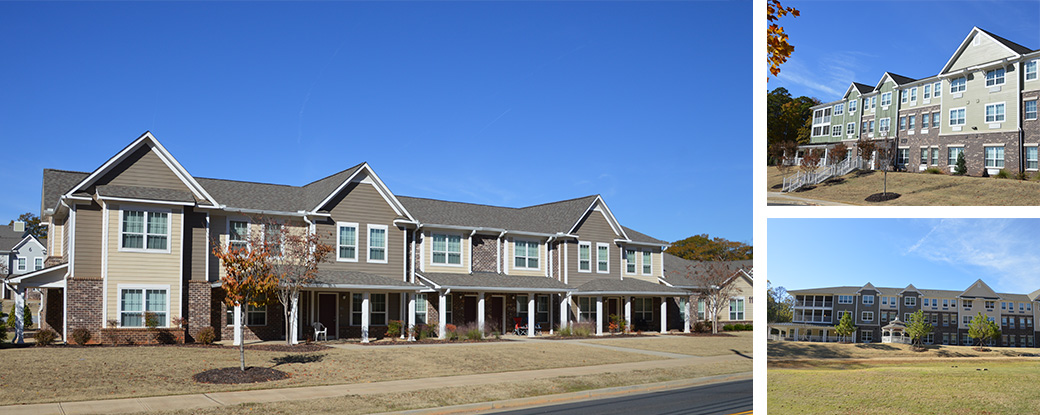News & Views
Problem Solving in Griffin, GA

By Mark Straub
The redevelopment of Griffin is an amazing story. Griffin is a very small town between Atlanta and Macon that has made dramatic improvements to its neighborhoods and for its residents.
We’re especially proud of this project because of all the hard work and team collaboration it took to make it a reality. Today, we’re talking with Mark Straub (Regional Vice President at Pennrose) to learn about the development, challenges, and how project partners worked together to problem-solve.
Mark, to start, can you give us background on the development? How did Pennrose become involved?
In 2012, the Griffin Housing Authority put out a competitive solicitation for the redevelopment of an outdated public housing site with 120 units. They wanted a partner to assist with demolition of the former Meriwether Homes and create new, high-quality affordable housing options for local residents.
It was a very exciting opportunity because there hadn’t been any new, multifamily development in Griffin in more than a decade and the project would be a huge benefit to the local neighborhood. As we began designing the multi-phase master plan, we sought community involvement, worked with the Housing Authority to expand local partnerships, and consulted closely with the City. Our team created a collaborative of stakeholders who were invested in the site and had a commitment to moving the plans forward.
You mentioned the master plan. Can you describe the full initiative?
The master plan for the site included three phases, with the ultimate goal of revitalizing the Meriwether corridor and spurring further economic development in the neighborhood.
The first phase, The Oaks at Park Pointe, includes 84 affordable, townhome-style units for families. The second and third phase, Iris at Park Pointe and Terraces at the Park, were designed for seniors and created 153 affordable apartments in total. All three residential buildings are energy efficient and each offers a number of high-quality community amenities – everything from fitness centers to a computer lab, craft room, and outdoor picnic areas.
We celebrated the grand opening of Terraces at the Park in 2018, and it was a very special milestone because it marked the conclusion of the Meriwether Homes redevelopment, but it also signified a bright future for the neighborhood. There are now even plans in the works for market-rate, single-family homes nearby which demonstrates the positive impact real estate investment can have on a community.
This seems like a significant undertaking. Were there any initial obstacles? What were the solutions?
We realized early on the only way to accomplish this comprehensive redevelopment in Griffin was through 9% LIHTC awards, but the awards are very competitive and Georgia's Qualified Allocation Plan recently changed. Points are awarded based on different criteria – such as location, project characteristics, and energy efficiency. Many aspects of the proposed site were complementary to the development of affordable housing, but to earn additional points and meet the state’s scoring criteria we needed to be creative.
We worked collaboratively with project and community partners to maximize plans for the site and tell a positive, expansive story about the different programs, activities, and approaches that could complement the project and make it a true community asset. Our approach was successful – we were awarded three consecutive Federal Home Loan Bank awards, which is unheard of in Georgia. The project even won the 2016 Charles L. Edson Tax Credit Excellence Award in the Public Housing category.
That’s amazing. Can you describe Pennrose’s approach? How did you work creatively to better meet requirements?
Sure. As I mentioned, the goal of the master plan redevelopment was to integrate the site back into the surrounding neighborhood. For instance, the location is within walking distance to a nearby city park so we decided to incorporate walking trails so residents would have easy access to the public green space. There is also nearby retail and a police station which made it a safe environment.
There is a Salvation Army facility adjacent to our site with a gym, programming, and a brand new playground. We partnered with the Salvation Army to provide additional amenities at the facility and allow families living in the residential community to utilize the playground. Another key factor in scoring points for tax credit allocations was public transit availability. Unfortunately, there wasn’t public transportation nearby, but the project partners worked with the City to set up a loop to shuttle residents to and from common locations – such as the grocery store, drug store, and other important destinations. We advertised the shuttle routes so neighbors could also take advantage.
It was all kinds of little, strategic connections in the master plan to make the project an integral part of the community.